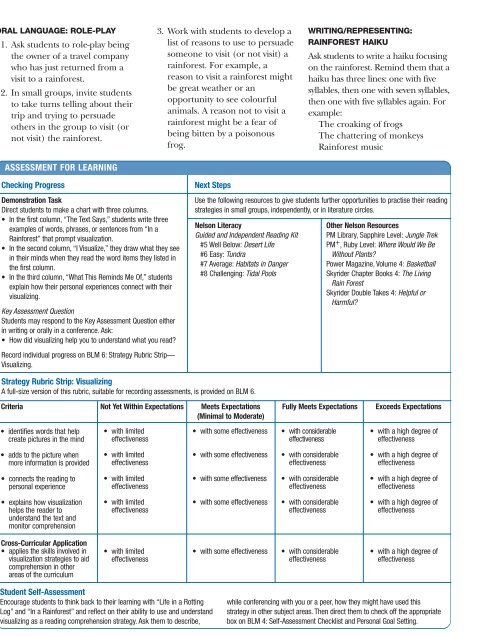Teacher's Resource - Nelson Education
Teacher's Resource - Nelson Education
Teacher's Resource - Nelson Education
Create successful ePaper yourself
Turn your PDF publications into a flip-book with our unique Google optimized e-Paper software.
ORAL LANGUAGE: ROLE-PLAY<br />
1. Ask students to role-play being<br />
the owner of a travel company<br />
who has just returned from a<br />
visit to a rainforest.<br />
2. In small groups, invite students<br />
to take turns telling about their<br />
trip and trying to persuade<br />
others in the group to visit (or<br />
not visit) the rainforest.<br />
ASSESSMENT FOR LEARNING<br />
3. Work with students to develop a<br />
list of reasons to use to persuade<br />
someone to visit (or not visit) a<br />
rainforest. For example, a<br />
reason to visit a rainforest might<br />
be great weather or an<br />
opportunity to see colourful<br />
animals. A reason not to visit a<br />
rainforest might be a fear of<br />
being bitten by a poisonous<br />
frog.<br />
WRITING/REPRESENTING:<br />
RAINFOREST HAIKU<br />
Ask students to write a haiku focusing<br />
on the rainforest. Remind them that a<br />
haiku has three lines: one with five<br />
syllables, then one with seven syllables,<br />
then one with five syllables again. For<br />
example:<br />
The croaking of frogs<br />
The chattering of monkeys<br />
Rainforest music<br />
Checking Progress<br />
Demonstration Task<br />
Direct students to make a chart with three columns.<br />
• In the first column, “The Text Says,” students write three<br />
examples of words, phrases, or sentences from “In a<br />
Rainforest” that prompt visualization.<br />
• In the second column, “I Visualize,” they draw what they see<br />
in their minds when they read the word items they listed in<br />
the first column.<br />
• In the third column, “What This Reminds Me Of,” students<br />
explain how their personal experiences connect with their<br />
visualizing.<br />
Key Assessment Question<br />
Students may respond to the Key Assessment Question either<br />
in writing or orally in a conference. Ask:<br />
• How did visualizing help you to understand what you read<br />
Record individual progress on BLM 6: Strategy Rubric Strip—<br />
Visualizing.<br />
Next Steps<br />
Use the following resources to give students further opportunities to practise their reading<br />
strategies in small groups, independently, or in literature circles.<br />
<strong>Nelson</strong> Literacy<br />
Guided and Independent Reading Kit<br />
#5 Well Below: Desert Life<br />
#6 Easy: Tundra<br />
#7 Average: Habitats in Danger<br />
#8 Challenging: Tidal Pools<br />
Other <strong>Nelson</strong> <strong>Resource</strong>s<br />
PM Library, Sapphire Level: Jungle Trek<br />
PM + , Ruby Level: Where Would We Be<br />
Without Plants<br />
Power Magazine, Volume 4: Basketball<br />
Skyrider Chapter Books 4: The Living<br />
Rain Forest<br />
Skyrider Double Takes 4: Helpful or<br />
Harmful<br />
Strategy Rubric Strip: Visualizing<br />
A full-size version of this rubric, suitable for recording assessments, is provided on BLM 6.<br />
Criteria Not Yet Within Expectations Meets Expectations Fully Meets Expectations Exceeds Expectations<br />
(Minimal to Moderate)<br />
• identifies words that help<br />
create pictures in the mind<br />
• with limited<br />
effectiveness<br />
• with some effectiveness<br />
• with considerable<br />
effectiveness<br />
• with a high degree of<br />
effectiveness<br />
• adds to the picture when<br />
more information is provided<br />
• with limited<br />
effectiveness<br />
• with some effectiveness<br />
• with considerable<br />
effectiveness<br />
• with a high degree of<br />
effectiveness<br />
• connects the reading to<br />
personal experience<br />
• with limited<br />
effectiveness<br />
• with some effectiveness<br />
• with considerable<br />
effectiveness<br />
• with a high degree of<br />
effectiveness<br />
• explains how visualization<br />
helps the reader to<br />
understand the text and<br />
monitor comprehension<br />
• with limited<br />
effectiveness<br />
• with some effectiveness<br />
• with considerable<br />
effectiveness<br />
• with a high degree of<br />
effectiveness<br />
Cross-Curricular Application<br />
• applies the skills involved in<br />
visualization strategies to aid<br />
comprehension in other<br />
areas of the curriculum<br />
• with limited<br />
effectiveness<br />
• with some effectiveness<br />
• with considerable<br />
effectiveness<br />
• with a high degree of<br />
effectiveness<br />
Student Self-Assessment<br />
Encourage students to think back to their learning with “Life in a Rotting<br />
Log” and “In a Rainforest” and reflect on their ability to use and understand<br />
visualizing as a reading comprehension strategy. Ask them to describe,<br />
while conferencing with you or a peer, how they might have used this<br />
strategy in other subject areas. Then direct them to check off the appropriate<br />
box on BLM 4: Self-Assessment Checklist and Personal Goal Setting.<br />
28 <strong>Nelson</strong> Literacy 4 Teacher’s <strong>Resource</strong>: Habitats and Communities<br />
NEL

















